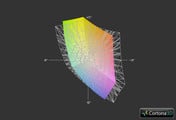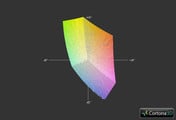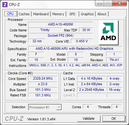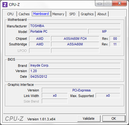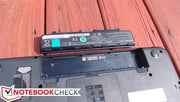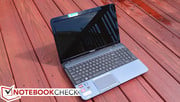东芝Satellite S855D-S5256 笔记本测评

Toshiba offers no fewer than four different 15.6-inch Satellite notebook varieties, each targeted at a slightly different market. At the bottom of the ladder, there’s the C Series, which provides only the essentials and is meant for those who are mostly concerned with price. Next comes the L Series, which steps up into mid-range performance with Intel Core i5 and AMD A8 APUs and integrated graphics. At the top end is the P series, which is crafted out of etched aluminum and features Intel Core i7 CPUs with either integrated or discrete graphics. And, finally, the S series—which is what we’re covering today with the S855D—is designed especially for those seeking a high-performance, entertainment-grade PC, but who wouldn’t mind compromising in just a few key areas in exchange for a lower cost.
Our Satellite S855D review unit includes an AMD A10-4600M quad-core APU with integrated Radeon HD 7660G graphics. Similarly-equipped models are available directly from Toshiba for around $700. As always, we subjected the notebook to a flurry of intensive tests, benchmarks, inspections, and comparisons. Grab a snack and let’s evaluate the S855D from top to bottom.
东芝提供没有少于四个不同的15.6英寸的Satellite笔记本品种,每个针对一个略有不同的市场。在梯子的底部,有C系列,它提供了唯一的要领,其目的是为那些谁是主要关心价格。接下来的L系列,中档性能的Intel Core i5和AMD A8 APU的集成显卡的步骤。在高端的P系列,打造出铝蚀刻和功能的英特尔酷睿i7处理器与集成或独立显卡。最后,S系列,这就是我们今天要覆盖与S855D是专为那些寻求高性能,娱乐级PC,但谁也不会想到在短短的几个关键领域妥协交流以较低的成本。
我们的卫星S855D审查单位包括AMD A10-4600M四核APU,集成Radeon HD7660G显卡。同样配车型都可以直接从东芝为700元左右。与往常一样,我们受到的笔记本电脑发出一阵密集的测试,基准测试,检查和比较。品尝小吃,让我们评估S855D从上到下。
Case
Immediately obvious is the primary point of compromise chosen by Toshiba in its design of the Satellite S-series: the casing and construction. It isn’t bad, but it is almost entirely comprised of plastic, implementing metal only where aesthetics benefit most from its application.
The entire core of the notebook is built from hard plastic. The underbody, sides, and trim are all plastic as well. These parts of the notebook can be flexed under moderate pressure and don’t provide much reassurance that the machine could withstand any sort of rough treatment or a minor drop. The area underneath the optical drive and any of the underside vents feel like they could potentially crack if even just squeezed a bit too much. The only metal to be found is on the palm rest (a decision which undeniably provides a classy illusion of sturdy construction) and the back of the display lid. Like that of the palm rest, the thin metal coating on the display lid also looks very nice, but it lacks the rigidity necessary to truly provide any substantial degree of protection against LCD stress and breakage. In short, the S855D comes off as a pretty fragile machine.
Fortunately, the display hinges seem very capable, supporting the screen well with very little wobbling. And elsewhere, the positive side of this approach to construction is a lighter overall weight than many all-metal notebooks. Besides, sturdiness isn’t necessarily the goal of this notebook; rather, it is the compromise between construction and performance which Toshiba hopes will add up to an irresistible price tag.
Although there isn’t much room for upgrades (more on that in a bit), thankfully, the S855D also provides easy access to the most important replaceable components. The bottom of the notebook features a single panel cutout covering both hard drive and memory, secured by just a single screw and some fairly cooperative plastic clips. The LCD screen, meanwhile, is relatively easy to access and remove in the event of breakage. Like most Satellite notebooks, following the removal of four concealed screws, the bezel snaps off from around the perimeter of the panel.
显而易见的是由东芝公司在其设计的卫星S-系列的主要选择的妥协点:壳体和建设。这是不坏,但它几乎完全由塑料制成,实施金属只有在美学从它的应用程序中受益最大的。
整个笔记本电脑的核心是建立由硬质塑料。车身底部,侧面和内饰都是塑料以及。这些部件可弯曲的笔记本在中等压力下,并没有提供太多的放心的是,该机可以承受任何形式的粗暴对待或轻微下降。光盘驱动器和下方的区域的底部通风口觉得他们可能破裂即使只是有点挤了太多。被发现的唯一的金属掌托上(一个的决定无可否认,提供一个优雅的假象,结构坚固)和背面的显示屏盖。上的显示屏盖的薄金属涂层的掌托一样,看起来也很不错,但缺乏必要的刚性,真正提供任何实质性的保护LCD的压力和破坏的程度。总之,S855D是一个相当脆弱的机器。
幸运的是,显示铰链显得非常有能力,支持在屏幕上用很少的摇摆。和其他地方的这种方式来建设的,积极的一面是较轻的整体重量比很多全金属的笔记本电脑。此外,坚固不一定是这款笔记本的目标,相反,它是结构和性能之间的妥协,东芝希望将添加到一个无法抗拒的价格标签。
幸运的是,虽然目前还没有很大的升级(更多的是在一个位),S855D还提供了轻松访问最重要的可更换组件。笔记本电脑的底部设有一个单一的面板开孔,包括硬盘驱动器,内存,只是一个单一的螺丝和一些相当合作的塑料夹子固定。液晶显示屏上,同时,是比较容易的访问和移除事件破损。像大多数卫星笔记本,去除后的四个隐蔽螺钉,挡板卡扣从面板周围的外围。
Connectivity
The Satellite S855D offers a merely average selection of expansion ports for a 15-inch machine. You’ll find just three total USB ports, two of which are USB 3.0 and one of which is USB 2.0 with sleep and charge. Apart from that, there are the usual two video output options (HDMI and VGA), and the bare minimum elsewhere. It’s enough to get the job done, but certainly nothing generous.
Plus, in spite of the decidedly small number of ports overall, the vast majority of them are all crammed along the right-hand side of the notebook with very little room in between. It’s a strange design seeing as the opposite (left) side of the notebook has quite a lot of empty real estate available. Fortunately, one of the lone ports on the left side is the USB 2.0 port, meaning that any larger-than-usual USB devices can be banished to it, leaving room for the more reasonably-sized connectors on the right side.
卫星S855D提供一台15英寸的机器上的扩展端口仅仅是平均水平的选择。你会发现总共只有三个USB端口,其中两个是USB3.0,其中一个是USB 2.0与睡眠和充电。此外,也有通常的两个视频输出选项(HDMI和VGA),和其他地方的最低限度。这是足以完成这项工作,但肯定没有什么大手笔。
另外,尽管整体的端口的决然小的,其中绝大多数都挤满沿着右手边的笔记本电脑之间的空间不大。这是一个奇怪的设计,看到的相反侧(左侧)的笔记本电脑有相当多的空房地产。幸运的是,一个左侧的孤端口是USB 2.0端口,这意味着,任何较大的比普通的USB设备可以被放逐到它,更合理大小的连接器,在右侧留出空间。
Communication
Our Saltellite S855D review notebook includes a single-band Realtek RTL8723AE 802.11n wireless network adapter supporting up to 150 Mbps in a 1x1 antenna configuration. There’s also a built-in Bluetooth 4.0 adapter which comes standard using the Realtek chipset. It’s disabled by default, but is easily activated using the wireless function key (F12) on the keyboard.
The initial wireless driver for the Realtek 802.11n adapter (dated 1/10/12) exhibited problems connecting to some Wireless-N networks at full speed. For instance, our 300Mbps MIMO Wireless-N network was only yielding speeds of 54 Mbps to the S855D when first connected. However, a driver update to the latest version of the wireless driver on Toshiba’s website (dated 8/6/12) corrected this problem. Post-update, the adapter now correctly connects to Wireless-N networks at its maximum possible speed of 150 Mbps.
It’s worth mentioning that there are no PCI-e mini slots available on the Satellite S855D. That means that if you’re hoping to connect to a WWAN network, you’ll need to invest in an external USB adapter compatible with the carrier of your choice.
Accessories
Provided with the notebook is a small 65W AC adapter, and that’s it. Apart from the larger battery options, not much else is offered to expand the functionality of the Satellite S-series notebooks. One isolated exception is the Toshiba dynadock Universal Docking Station (of which there is a standard and USB 3.0 variety), but these have been poorly-received by customers due to complaints about inconsistent and unreliable operation. The bottom line is that if you’re hoping for a suitable docking station option, you’ll either want to invest in a business-grade laptop with a dedicated docking station port on the bottom or look elsewhere.
Warranty
The standard warranty included with every Satellite S855D is one year, parts and labor (including the battery). Optional warranty upgrades are available to be purchased separately, including extended warranties, on-site warranty service packages, and accidental damage protection.
通讯
我们的Saltellite S855D审查笔记本包括单波段瑞昱RTL8723AE 802.11n无线网络适配器,支持高达150 Mbps的一个1x1的天线配置。还有一个内置的蓝牙4.0适配器,它采用了Realtek的芯片组标配。它在默认情况下是禁用的,但可以很容易地激活使用的无线键盘上的功能键(F12)。
最初的无线的,瑞昱802.11n的适配器(日期为12年1月10日)驱动程序的全速一些无线-N网络连接的问题。例如,我们达到300Mbps MIMO Wireless-N网络产生的54 Mbps的速度时,首先连接到S855D。然而,东芝的网站(日期为12年8月6日)的无线驱动程序的最新版本的驱动程序更新修正这个问题。更新后,适配器现在可以正确地连接到无线-N网络在其可能的最大速度为150 Mbps的。
值得一提的是,有没有PCI-E提供的卫星S855D的小槽。这意味着,如果你希望连接到WWAN网络,你需要投资在外部USB适配器兼容与您所选择的载体。
饰品
提供与笔记本电脑是一个小的65W AC适配器,这就是它。除了较大的电池选项,没有多少人愿意扩大卫星S-系列笔记本电脑的功能。一个孤立的例外是东芝dynadock通用基座(其中有一个标准的USB 3.0多种),但这些已经很差收到客户投诉不一致和不可靠的操作。底线是,如果你希望一个合适的停靠站选项,你要么要投资一个企业级的笔记本电脑的底部与一个专用的扩展坞端口,或看看其他地方。
保
每颗卫星S855D的标准保修是一年部件和人工(包括电池)。可选的保修升级可单独购买,包括延长保修期,现场保修服务包,以及意外损坏保护。
Input Devices
Keyboard
The chiclet-style keyboard included on the Satellite S855D features well-spaced keys that are, for the most part, intuitively laid out. However, the performance of the keyboard is a different subject. Keypresses provide very little travel and exhibit a subtle feedback which provokes a sort of subconscious cliffhanger as to whether or not the input actually registered. In some cases, they actually didn’t, probably because fast-moving fingers can easily tap the rather large (and flat) trenches between each key without it feeling much different from an actual keypress. This presents a pretty serious issue for quick typists, as they’re likely to be thinking too much about the actual act of typing to be focused on whatever it is they’re working on. Compared to, say, a ThinkPad keyboard (whether classic or AccuType) or a Dell Latitude keyboard, wefound the Satellite S855D’s considerably harder to adjust to. Over time, however, users are likely to grow used to the idiosyncrasies of the design, and the challenges are likely to diminish somewhat.
There is a full-sized number pad to the right of the keyboard to please those predisposed to data entry work. Tiny arrow keys inhabit a single-key-height space just to the left of it (below the right Shift key), and they’re just as hard to operate as it looks, compounding the issue with a terribly muted feedback and soft press. Finally, there’s a bit of flex to the keyboard as well, though it’s difficult to notice in general use because the keyboard encourages softer typing with its design.
Touchpad
On the bright side, the excellent Synaptics touchpad is comfortably large and accurate. It's soft, matte finish facilitates an easy glide of the finger across its surface, and the two buttons below it are quiet but decisive in their operation, offering a definite click and feeling tight and well-affixed. The affiliated Synaptics touchpad software includes the usual swath of available options and customizations ranging from multi-finger gestures to multiple scrolling methods, and full control of nearly every associated parameter.
希克莱式键盘上的卫星S855D功能,最直观地奠定了良好的间距键。不过,键盘的性能是不同的主题。按键提供了非常小的旅游呈现出微妙的反馈,通常会引起一种潜意识的悬念是否输入实际登记。在某些情况下,他们其实没有,可能是因为快速移动的手指可以很容易地挖掘了相当大的(平面)战壕每个按键之间没有很大的不同,从实际按键的感觉。这提出了一个相当严重的问题,快速的打字员,他们可能会想得太多了打字的实际行动,不管它是什么,他们正在努力把重点放在。相比,比方说,一台ThinkPad键盘(,无论是经典或AccuType的)或一个的戴尔Latitude键盘,wefound卫星S855D是很难调整。然而,随着时间的推移,用户可能会增加设计的特质,和所面临的挑战可能有所减弱。
有一个全尺寸的数字键盘,在键盘右侧,请那些易患数据录入工作。小小的箭头键居住在一个单键高度空间,它的左边(下图右Shift键),他们只是很难操作,因为它看起来与一个非常柔和的反馈和软压,加剧了问题。最后,还有一点的弯曲,虽然这是很难注意到,在一般的使用,,因为键盘鼓励柔软的输入,其设计的键盘,以及。
触摸板
在光明的一面,优秀的的Synaptics触摸板是舒适和准确的。它的软,粉嫩有利于容易滑动手指在其表面,而下面的两个按钮是宁静的,但在其经营的决定性因素,提供一个明确的点击和感觉紧张,以及贴。附属Synaptics触摸板软件包括通常的大片可用的选项和自定义,从多手指手势多个滚动的方法,并完全控制了几乎所有相关的参数。
Display
The Satellite S855D features a brighter-than-average standard HD (1366x768) glossy display panel with subjectively attractive color reproduction. The level of saturation appeared comfortable but not overbearing. In spite of the disappointing black value and contrast ratio and the as-expected narrow viewing angles, the only real complaint we found with the display was the high-gloss finish, which limits its use in many brighter environments.
In terms of raw numbers, the panel’s average luminosity of 238 nits is only slightly betrayed by its brightness distribution of 82%; the center of the display is the brightest point (at 262 nits), and you have to really squint to notice much of a difference even in the darkest regions. It’s bright enough that even moderate brightness levels will likely please most users—average brightness is achieved at around level 6. Meanwhile, the black value of 1.86 is quite high, leading to a disappointing contrast ratio of just 141:1.
卫星S855D拥有一个美好的高于平均水平的标准HD(1366×768)镜面显示面板与主观诱人的色彩再现。出现饱和度的舒适,但不霸道。尽管令人失望的黑色值和对比度,为预期的视角窄,唯一真正的投诉,我们发现与显示器是高光泽,这限制了它在许多明亮的环境中使用。
面板的平均亮度238尼特的原始数据,只稍微背叛了它的亮度分布的82%;显示中心是在最亮的点(262尼特),和你有真正眯到注意到大部分一个即使在最黑暗的区域差异。这是足够明亮,即使是温和的亮度水平可能会请用户平均亮度达到6级左右。同时,黑值的1.86是相当高的,导致一个令人失望的对比度只有141:1。
| |||||||||||||||||||||||||
Brightness Distribution: 82 %
Center on Battery: 262 cd/m²
Contrast: 141:1 (Black: 1.86 cd/m²)52.5% AdobeRGB 1998 (Argyll 2.2.0 3D)
72.9% sRGB (Argyll 2.2.0 3D)
50.8% Display P3 (Argyll 2.2.0 3D)
The color spectrum coverage of the panel just about makes up for it, though, scoring a fairly decent 78% coverage of sRGB. While still a ways off from complete coverage of the spectrum, this is better than many low-budget TN panels, and the results are palpable in daily use. Our earlier impressions of the “attractive” color reproduction have this to thank. Compared to, for instance, the Dell Inspiron 14R-N4110, it’s easy to see the difference (as illustrated by the graph below).
面板的颜色光谱覆盖范围几乎弥补了它,尽管取得了相当体面的78%覆盖范围的sRGB。方式虽然仍是一个完全覆盖的频谱,这是比许多价格低廉的TN面板,在日常使用中,其结果是显而易见的。我们的早期印象“有吸引力”的色彩还原有此感谢。相比,例如,戴尔Inspiron14R-N4110,它很容易看出其中的差别(如下面的图表所示)。
As you might expect, in spite of the better-than-average brightness, outdoor use is only really practical in shaded areas. The glossy finish is highly reflective and produces notable obstructions any place where bright light is facing the screen—including indoors in front of windows and bright lights. However, in the shade, the notebook’s screen is perfectly tolerable.
正如你所预料的,在虽然优于平均亮度,室外使用的是只有真正实用的阴影区域。是高反射的表面有光泽,明亮的光线正面临着前面的窗户和明亮的灯光在屏幕上,包括在室内任何地方,并产生显着的障碍物。然而,在树荫下,在笔记本电脑的屏幕是完全可以容忍的。
Perhaps as expected, the merely average TN panel included in the S855D possesses the all-too-familiar narrow viewing angles. Moving anywhere close to the 45 degree mark in any direction produces notable color distortion and makes reading anything on the screen quite a challenge.
也许预期的一样,只是在S855D平均TN面板拥有所有太熟悉的视角窄。移动任何地方接近45度的标记在任何方向上产生明显的色彩失真和读什么在屏幕上相当大的挑战。
Performance
Although the S855 series of notebooks is available with both AMD and Intel offerings, our particular review unit included an AMD chipset. The AMD choices are the least expensive of the bunch, but it’s possible to select a processor as powerful as the Intel Core i7-3610QM if your budget allows. Each variation is denoted by a different suffix; our review model (specifically, the Satellite S855D-S5256) features a pseudo-quad-core (more on this in a moment) AMD A10-4600M APU, which leverages the latest platform from the chip maker, codenamed Trinity. Trinity introduces Turbo Core 3.0, which (like Intel’s Turbo Boost) provides an automatic overclock of the processor in situations where additional performance is warranted, provided there is thermal headroom available to accommodate it.
The A10-4600M has a base clock rate of 2.3 GHz and can automatically overclock all the way to 3.2 GHz when called for. With a TDP of 35W, the power consumption is also pretty reasonable. Earlier we mentioned that it is a “pseudo-quad-core” processor; what we mean by that is that it actually only includes two modules with four integer-cores and two floating-point cores. Moreover, the Turbo Core 3.0 functionality isn’t as effective as Intel’s Turbo Boost, though single-threaded performance is considerably better than the Llano precursors.
Arguably more interesting than CPU performance is the on-die Trinity GPU, which is considerably faster than any other integrated graphics solution. Each Trinity processor includes a different GPU—with the A10-4600M we received packing a Radeon HD 7660G. Again similar to Intel’s approach, this GPU scales its core speed based on the application, in this case with clock rates ranging from 497 to 686 MHz. The performance is comparable in most cases to that of a Radeon 6630M discrete graphics card—which is impressive. For more specific information on the performance of this processor in dozens of games and other benchmarks, don’t miss our special Trinity in Review: AMD A10-4600M APU article.
The 6 GB of DDR3 RAM in our system was reached by combining a Kingston 2 GB and a Samsung 4 GB SODIMM, both 1600 MHz (PC3-12800) speed. Up to 8 GB DDR3-1600 RAM is supported, which should be plenty for just about any application.
As always, we tested the system using DPC Latency Checker to assess its ability to stream audio and video without dropouts or stutters. Even with all wireless radios (Wi-Fi and Bluetooth) enabled, the DPC latency never rose far above 500 µs, which is excellent.
虽然S855系列笔记本电脑是与AMD和英特尔的产品,我们特别审查单位包括AMD芯片组。 AMD的选择是最便宜的一群,但它可以选择一个功能强大的英特尔酷睿i7-3610QM处理器,如果你的预算允许的。每一个变化是由不同的后缀表示,我们的审查模式(特别是卫星S855D-S5256)提供一个伪四核的(关于这一点在某一时刻)的AMD A10-4600M APU的芯片,它利用最新的平台制造商,代号为三位一体。三一推出涡轮增压的核心(如英特尔的Turbo Boost)3.0,提供了自动超频的处理器的情况下,额外的性能是必要的,有可容纳的散热空间。
A10-4600M具有基部2.3 GHz的时钟速率,并可以自动超频至3.2 GHz的方式调用时。随着TDP为35W,功耗也是相当合理的。前面我们提到,这是一个“伪四核”处理器,我们的意思是,它实际上只包括两个模块,4个整数核心,和两个浮点核心的。此外,Turbo的核心3.0的功能是不一样有效,英特尔的Turbo Boost,虽然单线程性能大大优于Llano的前体。
比CPU的性能可以说是更有趣的是三位一体的GPU芯片,这是大大快于任何其他的集成图形解决方案。每个的三位一体处理器包括一个不同的GPU-A10-4600M,我们收到包装的Radeon HD 7660G。同样类似英特尔的做法,这个的GPU尺度的基础上,应用的核心速度,在这种情况下,从497到686 MHz的时钟速率。的性能在大多数情况下,一个Radeon 6630M独立显卡卡,这是令人印象深刻。对于这款处理器的性能在许多游戏和其他基准的更具体的信息,千万不要错过我们的特别三位一体的评论:AMD A10-4600M APU的文章。
6 GB的DDR3内存,在我们的系统相结合,达到了金士顿2 GB和三星的4 GB SODIMM,无论是1600兆赫(PC3-12800)的速度。支持高达8 GB DDR3-1600内存,为几乎任何应用程序应该有很多。
与往常一样,我们测试的系统使用DPC的时延检查,以评估其能力,流音频和视频,而无需辍学或口吃。启用即使所有的无线电(Wi-Fi和蓝牙),DPC延迟从未涨幅远高于500微秒,这是极好。
Processor
While it may not be of paramount importance to the average entertainment/gaming PC user, the A10-4600M’s actual CPU performance truly isn’t very good. It’s slower in most cases than even an Intel Core i3-2310M (Sandy Bridge, last generation), and much slower than equivalent Ivy Bridge processors. If single-core/older benchmarks are excluded, its performance appears more favorable, coming closer to the midrange Intel Core i5 Sandy Bridge CPUs. However, nothing rivals the newer Ivy Bridge offerings—especially those at the top of the ladder. Still, it would be silly to classify the CPU as sluggish, as it still zips through everyday tasks without any hesitation, and the powerful integrated GPU makes for a sometimes better combo than a comparable Intel chipset. It’s just that Intel’s CPU offerings are so much faster.
Thus far, the closest notebooks in terms of specs that have come through our offices have had their Trinity GPUs paired with an accompanying discrete GPU (namely, the HD 7670M). As such, it’s difficult to draw comparisons between the performances of the different models when the GPU speed has some bearing on the results. However, in terms of CPU only, we can compare with the Acer Aspire V3-551G-10468G50Makk and the HP Pavilion g7-2051sg, both of which yield nearly identical results in the Cinebench R10 and R11.5 CPU tests (the differences in scores between the three notebooks are negligible at generally less than 2%).
The performance of the GPU, on the other hand (which we’ll cover in much more detail later in our review) is impressive. It’s powerful enough to handle most games fluidly on medium (many even high) settings, and will please most users who plan to game on the go and don’t want to sacrifice the battery life associated with heavier-duty, power-hungry gaming notebooks. In terms of integrated graphics, it effortlessly sets a new standard.
As always, we reran a couple of benchmarks on battery power to ensure the notebook’s performance wouldn’t suffer. The scores didn’t budge materially versus their AC power counterparts in either 3DMark 05 (9858 on battery versus 9865 on AC) or Cinebench R10 64-bit multi-CPU (8168 on battery versus 8183 on AC), confirming that the notebook is perfectly suitable for heavy-duty use while unplugged.
处理器
虽然它可能不是平均的娱乐/游戏PC用户是非常重要的,A10-4600M的CPU实际的表现确实是不太好。在大多数情况下,它的速度甚至比英特尔酷睿i3-2310M(Sandy Bridge的上一代),比同等的Ivy Bridge处理器要慢得多。如果single-core/older基准被排除在外,它的表现似乎更有利,更接近中端的Intel酷睿i5 Sandy Bridge的处理器。然而,没有任何对手的新的Ivy Bridge的产品,特别是那些在梯子的顶端。不过,这将是愚蠢的CPU分类为呆滞,没有任何的犹豫,因为它仍然拉链通过日常任务,和功能强大的集成GPU,有时比Intel的同类芯片组的组合。这只是英特尔的CPU产品是如此之快。
到目前为止,最亲密的笔记本电脑的规格来通过我们的办公室有他们的三位一体随后的离散GPU(即HD 7670M)GPU(图形处理器)搭配。因此,它的困难时,GPU的速度有一定的影响的结果的不同型号之间的性能比较。然而,在CPU只,我们可以与宏碁Aspire V3-551G-10468G50Makk和惠普Pavilion G7-2051sg,这两个产生几乎相同的结果,在CINEBENCH R10和的R11.5 CPU测试(,成绩的差异比较三者之间的笔记本是可以忽略的在一般小于2%)。
的GPU的性能,另一方面(我们将介绍更多的细节在我们的检讨中)是令人印象深刻。它的功能强大,足以应付大多数游戏流畅介质(许多人甚至高)设置,并会取悦大多数用户在旅途中,计划到游戏不希望牺牲电池的使用寿命与更重的责任,耗电的游戏笔记本电脑。在集成显卡方面,它毫不费力地设置了新的标准。
与往常一样,我们重新运行一对夫妇的基准,在电池供电,以确保笔记本电脑的性能也不会受到影响。与他们的交流电源的同行在任的3DMark 05的得分没有让步重大(9858 9865上电池与AC)或Cinebench R10的64位多CPU(8168电池与8183 AC),确认该笔记本完美适用于重型的使用,而拔出。
System Performance
To help assess general overall performance of each system, we use PCMark synthetic benchmarks, which are adversely affected by any relevant bottlenecks (such as a weak CPU or a sluggish hard drive). The Satellite S855D turned in thoroughly average scores of 5373 and 1926 on PCMark Vantage and PCMark 7 respectively, suggesting that the notebook’s performance is in line with most lower-end Intel models, even some low-voltage CPUs. It’s certainly the CPU that is primarily to blame for this lower-than-desired score.
Still, as emphasized earlier, slowdown isn’t evident during everyday use. Subjectively speaking, the notebook seems perfectly capable as a primary machine, yielding only to CPU-heavy tasks such as video encoding. Similar to how many users have learned to accept low-voltage chipsets as suitable for everyday computing needs in exchange for a lighter-weight machine, so will many people find solace in the better-than-average GPU performance and lower cost of an AMD A10 notebook when considering their options. And, as is often the case with many so-called Ultrabooks (which generally feature the aforementioned low voltage CPUs), it’s a solid state drive (SSD) which can truly boost the perceived performance of a typical system.
系统性能
为了帮助评估每个系统的整体性能,我们使用PCMark合成基准测试,它受到不利影响的任何相关的瓶颈(如弱的CPU或一个缓慢的硬盘驱动器)。卫星S855D打开PCMark Vantage的5373年和1926年和PCMark7彻底的平均分数,表明是在符合最低端的英特尔车型,甚至是一些低电压CPU的笔记本的性能。这是肯定的CPU,主要是归咎于这低于所需的分数。
不过,正如我刚才强调的经济增长放缓是日常使用过程中并不明显。从主观上讲,笔记本电脑似乎完全有能力作为一个主要的机器,收益率只有CPU繁重的任务,如视频编码。类似有多少用户已经学会了接受低电压芯片组,适合日常计算需求,以换取一个重量更轻的机器,所以很多人找到安慰优于平均水平的GPU(图形处理器)性能和更低的成本的AMD A10笔记本电脑时,考虑他们的选择。 ,这是常有的情况下,很多所谓的Ultrabooks(通常采用上述低电压CPU),它是一种固态驱动器(SSD),它可以真正提高一个典型的系统的感知性能。
| PCMark Vantage Result | 5373 points | |
| PCMark 7 Score | 1926 points | |
Help | ||
Storage Devices
Speaking of storage devices as bottlenecks, the Satellite S855D’s chosen hard drive is actually quite good for a 5,400 RPM model. Our review unit included a large TOSHIBA MQ01ABD075 750 GB 5,400 RPM hard drive. Since the system isn’t configurable, this is the only available option for this specific model (though, of course, brands and models may vary and are not explicitly stated on the specifications page).
This drive turns in a 76.7 MB/s transfer rate, which is actually a great score for a 2.5-inch 5,400 RPM drive. Still, since such better options are available in the way of 7,200 RPM models and SSDs, if you’re looking to upgrade something, this might be the first place to start. On the other hand, it does provide a ton of storage space, which is a plus if you’re planning on using the notebook for its intended purpose (an entertainment device, where likely plenty of large video would be involved).
Something which we found unnerving was a periodic “click” emitted by the drive that was quite audible indeed. This seems to occur at regular intervals and is difficult to ignore in a quiet room. The case design may be as much to blame as the drive itself in this instance, however, as the plastic panel on the bottom features a large vent just underneath the drive’s location near the front of the notebook that unintentionally functions like a down-firing speaker. In other words, when the notebook is located on a hard surface, the sounds of the hard drive are seemingly amplified by this design.
在谈到存储设备的瓶颈,卫星S855D选择的硬盘驱动器实际上是相当不错的5,400 RPM模型。我们的审查单位,包括一个大的东芝MQ01ABD075750 GB5400 RPM硬盘驱动器。由于该系统是不可配置的,这是唯一可行的选择(尽管这个特定的模式,当然,品牌和型号可能会有所不同,并没有明确规定的技术规格页)。
该驱动器变成了一个76.7 MB / s的传输速率,它实际上是一个伟大的成绩了一块2.5英寸5400 RPM驱动器。不过,在7,200 RPM模式和固态硬盘的方式,因为这样可更好的选择,如果你想升级的东西,这可能是第一个开始的地方。另一方面,它提供了一吨的存储空间,这是一个加号,如果你打算使用笔记本电脑,其预期的目的(娱乐设备,其中可能大量的大型视频将参与)。
我们发现的一些东西,让人不安的是“,单击”驱动器所发出的声音确实是相当一个周期。这似乎是发生在固定的时间间隔,是难以忽视的,在一个安静的房间。的情况下,设计为多造成的驱动器本身在这种情况下,然而,作为的塑料面板的底部设有一个大泄刚下驱动器的位置附近的笔记本电脑的前面无意功能像一个向下的射击扬声器。换句话说位于坚硬的表面上,当笔记本的硬盘驱动器,声音似乎是通过这样的设计放大。
Gaming Performance
Although the Satellite S855D is classified as an entertainment notebook, it’s also perfectly capable of playing some games. That’s thanks to AMD’s new Trinity GPU, which promises performance close to many low- to mid-range discrete adapters. The Satellite S855D includes the top-end AMD mobile APU, which, as logic would suggest, is also paired up with the top-end integrated GPU: the Radeon HD 7660G. Though we’ve tested the GPU before in the past pretty extensively, we wanted to get an idea of how this particular model stacks up against our previous numbers.
We chose Blizzard’s latest, Diablo III, to see if the numbers matched those of our previous tests. Although the results weren’t congruent with our previous findings (possibly due to driver differences or other variations in testing), we were still extremely pleased with the performance of the 7660G, which was easily able to handle the game on any settings we threw at it. For instance, on High settings, which we define as 1366x768 resolution, Textures, Shadows, Physics, and Clutter Density all on High, and Anti-Aliasing On, the notebook still managed an excellent 41 frames per second.
游戏性能
卫星S855D虽然被归类为一款娱乐笔记本,它也完全有能力玩一些游戏。这是由于AMD的GPU,新的三位一体保证性能接近低到中档的离散适配器。卫星S855D包括最高端的AMD移动APU的逻辑,建议,也配对了最高端的集成GPU的Radeon HD7660G。虽然我们在测试之前的GPU在过去相当广泛,我们希望得到一个想法,这个特殊的模型栈对我们以前的号码。
我们选择了暴雪的暗黑破坏神III,如果号码匹配那些我们以前的测试。虽然成绩不相一致,与我们以前的研究结果(可能是由于驱动程序测试的差异,或其他变化),我们还是非常高兴的7660G的性能,可以非常容易地处理任何设置,我们扔在游戏它。例如,在高级设置中,我们定义为1366x768分辨率,纹理,阴影,物理和杂波的密度都高,和抗锯齿,笔记本电脑仍
| 3DMark 03 Standard | 20650 points | |
| 3DMark 05 Standard | 9865 points | |
| 3DMark 06 Standard Score | 7318 points | |
| 3DMark Vantage P Result | 4476 points | |
| 3DMark 11 Performance | 1147 points | |
Help | ||
| low | med. | high | ultra | |
|---|---|---|---|---|
| Diablo III (2012) | 56 | 42 | 41 |
Emissions
System Noise
The Satellite S855D fares quite well in the category of noise. While idle, it turns in a reasonable average score of 31.6 dB, with almost no deviation from that value. Under load, meanwhile, the noise rises to a median level of 34.9 dB, with a maximum of 38 dB—certainly audible, but far from disturbing. Further supporting its cause is an unobtrusively pleasant fan “whoosh” tone versus the whine of many other systems, as well as a general lack of pulsation and other irritating fan programming mishaps.
The only time the system becomes bothersome in its noise level is when the optical drive is at work; DVD playback and access noise levels come to 40.5 and 43.5 dB respectively. The Blu-ray drive in general just seems to be a rather noisy variety, probably covered by what is a very thin sheathing of hard plastic (at least, that area of the case flexes enough under pressure to support that theory).
卫星S855D票价类别中的噪音相当不错。处于闲置状态时,它变成了一个合理的平均得分为31.6分贝,几乎没有偏差,从该值。同时,根据负载,噪音上升到平均水平为34.9分贝,38分贝肯定声音最大的,但远离干扰。进一步支持其原因是悄悄地愉快的风扇“嗖”音与嗲的许多其他系统,以及普遍缺乏的脉动等刺激性风扇的编程事故。
光盘驱动器是在工作时,系统变得麻烦在其噪音水平是唯一的一次,DVD播放和访问的噪音水平分别为40.5和43.5分贝。一般的Blu-ray驱动器似乎是一个比较嘈杂的品种,可能涵盖的是一个非常薄的护套硬质塑料(至少有足够的下压力来支持这一理论,该区域的情况下弯曲)。
Noise Level
| Idle |
| 31.5 / 31.6 / 31.8 dB(A) |
| DVD |
| 40.5 / 43.5 dB(A) |
| Load |
| 34.9 / 38 dB(A) |
 | ||
30 dB silent 40 dB(A) audible 50 dB(A) loud |
||
min: | ||
Temperature
The Satellite S855D has little to be ashamed of in the area of heat. AMD chipsets have always been less efficient than their Intel brethren, but perhaps the previously-discussed quiet operation of the S855D also plays a part in occasionally higher-than-desired temperatures.
Fortunately, the heat is distributed in such a way that, even when under load, the notebook doesn’t become too uncomfortably hot to use. The top of the notebook never reached above 42.6°C in our testing, and that value was only found overtop the number pad area. The next highest reading was 40°C in the center of the keyboard. Meanwhile, the bottom of the machine heats up to 44.2°C in the center when stressed, a value which most people will not appreciate, but which is easily avoided by moving one’s legs to the sides of the notebook, where temperatures are noticeably cooler.
Idle use provides better numbers overall, but most of which are still much higher than that of competing notebooks with Intel chipsets. The top of the notebook still saw numbers hovering around 36°C, while the bottom reached a puzzling 38.4°C. None of these numbers are problematic from a typical usage standpoint, but there exist notebooks that idle at 5 to 10°C cooler than this model, so it’s still worth considering.
温度
卫星S855D没有什么可羞愧的,在该地区的热量。 AMD芯片组一直是英特尔的弟兄们比他们的效率较低,但也许是前面讨论的安静运行的S855D也扮演了一个角色有时在高于所需的温度。
幸运的是,以这样的方式,即使在负载下,笔记本不会变得太不舒服热使用热分布。在我们的测试中,笔记本电脑的顶部从来没有达到过42.6°C以上,才发现该值过高的数字键盘区。下一个最高的读数为40℃,在键盘的中心。与此同时,在机器底端加热上升至44.2°Ç的中心时强调,大多数人不欣赏,但它是容易避免将一个人的腿移动的笔记本电脑,那里的温度有明显冷却器两侧的值。
空闲的使用提供了更好的整体数字,但其中大部分仍远高于的竞争与英特尔芯片组的笔记本电脑。笔记本电脑的顶部仍然徘徊在36°C的数字,而底部达到了一个令人费解的38.4°C。从一个典型的使用的角度来看,这些数字是没有问题,但还存在笔记本电脑,闲置5至10°C的温度比这个模型,所以它还是值得考虑的。
(±) The maximum temperature on the upper side is 42.6 °C / 109 F, compared to the average of 36.9 °C / 98 F, ranging from 21.1 to 71 °C for the class Multimedia.
(±) The bottom heats up to a maximum of 44.2 °C / 112 F, compared to the average of 39.2 °C / 103 F
(±) In idle usage, the average temperature for the upper side is 33.9 °C / 93 F, compared to the device average of 31.3 °C / 88 F.
(+) The palmrests and touchpad are reaching skin temperature as a maximum (34.2 °C / 93.6 F) and are therefore not hot.
(-) The average temperature of the palmrest area of similar devices was 28.8 °C / 83.8 F (-5.4 °C / -9.8 F).
Throttling
We leverage Prime95 and Furmark to impose maximal load on a system. Our prescribed testing here includes a CPU stress test, a GPU stress test, and finally, a combined stress test where both CPU and GPU are subjected to maximal load.
One of the improvements Trinity introduces is the ability to scale not only the CPU clock rate based on performance needs (which was already done in Llano), but also the GPU clock rate, provided there is thermal headroom available. It stands to reason that this should result in improved performance in many graphics-heavy applications, but the question remains, how effective is the performance when the system is under heavy load?
The Turbo Core 3.0 functionality seems to work most of the time as intended, but some of the observations were a bit puzzling. When the CPU only was stressed, only one of the four pseudo-cores actually remained near the base clock rate of 2.3 GHz; the others hovered closer to 2 GHz. Rarely did the clock rates even brush up against 2.7 GHz. When the GPU only is under stress, we observe all four cores running at 2.7 GHz (though in subsequent testing the clock rates jumped around more often). Meanwhile, the GPU clock rates fluctuate about as wildly as the CPU clock rates did in our CPU stress test. Thermals for both tests hovered between 65°C and 70°C.
Finally, under full system stress (GPU and CPU), we once again witnessed wild fluctuations in clock rates, with the CPU cores ultimately resting around a value of 1.6 GHz each. The GPU clock rate occasionally jumped to its maximum Turbo Core frequency of 686 MHz, but mostly remained at 497 MHz, which is the base clock rate. As you can see from the GPU-Z graph in the screenshot we posted, there were also periods where the GPU clock rate dropped below its base clock rate to around 335 MHz, which qualifies as throttling. However, again, this only seems to occur under very heavy system stress. Thermals once again remained near 70°C throughout all of this, occasionally rising slightly higher (at one point to nearly 75°C).
It’s not clear, but this inconsistent performance could either be due to suboptimal Turbo Core 3.0 implementation or Toshiba’s thermal design. Judging by an analysis of detailed log files, it does appear that most of the throttling occurred north of around 67°C, which may be close to the thermal ceiling set by the system firmware before throttling is employed. The fan, meanwhile, reportedly never ran at higher speeds than around 3,500 RPM. And as we mentioned earlier, the relative lack of noise supports that reading.
节流
我们充分利用Prime95和FurMark进行征收最大负荷的系统上。我们这里规定的测试包括CPU压力测试,GPU压力测试,终于,一个组合的压力测试CPU和GPU都受到最大负荷。
一个的改进三位一体介绍的扩展能力不仅是CPU的时钟频率根据性能需求(这是已经完成的Llano),同时也是GPU时钟速率,提供有散热空间。按理说,这应该导致在许多图形密集型应用的性能提高,但问题仍然存在,如何有效的方法是当系统在重负载下的性能?
3.0涡轮增压核心功能似乎大部分的时间预期,但一些意见是有点令人费解。当CPU只是强调,只有四个伪核心实际上仍然在基地附近的时钟频率为2.3 GHz的;徘徊的人接近到2 GHz。也罕见的时钟速率,即使刷了针对2.7 GHz的。当GPU处于压力之下,我们观察到所有四个核心运行在2.7千兆赫(虽然在随后的测试中,更经常地蹦来跳去的时钟速率)。同时,GPU时钟速率波动狂野的CPU时钟速率,在我们的CPU压力测试。这两项测试的散热为65°C和70°C之间徘徊
偶尔的GPU时钟速率跃升至其最大睿频可达686 MHz的核心频率,但大多仍保持在497兆赫,这是基本时钟速率。正如你可以看到从GPU-Z图,我们发布的截图中,也有GPU时钟速率下降到低于其基本时钟速率335 MHz的周围,有资格作为节流的时期。再次,然而,这似乎只是发生在非常沉重的系统压力。再次保持在接近70°C的散热整个这一切,偶尔略有上升(在一个点上,近75°C)。
目前尚不清楚,但这种不一致可能是由于不理想的涡轮核心3.0实施或东芝的散热设计的性能。详细的日志文件分析来看,它似乎大部分的节流发生在北部约67°C,这可能是采用节流前的热上限由系统固件。同时,风扇,据说从来没有运行在更高的速度比约3,500 RPM。正如我们前面提到的噪音,相对缺乏支持,阅读。
Speakers
The Satellite S855D’s speakers perform better than expected. While every notebook of its relative thinness are invariably lacking in low frequency response, the trebles are perfectly clear, and the volume is adequate. Stereo separation is notable and games and movies sound very good. There is some degree of flatness in the midrange, but it’s still pretty good for a notebook. This is an area which makes sense to have received attention considering the S855D’s marketed purpose as a budget entertainment notebook.
卫星S855D的扬声器的表现好于预期。虽然其相对薄的每一个笔记本都不约而同地缺乏低频响应,高音清透,量是足够的。立体声分离度是显着的,游戏和电影音效非常的不错。存在一定程度的平整度在中端,但它仍然是相当不错的笔记本。这是一个领域,这是有道理的,注意考虑S855D的销售预算作为娱乐笔记本的目的。
Battery Life
While it goes without saying that Trinity can’t compete with Intel’s Ivy Bridge architecture thanks largely to the 22 nm manufacturing process (versus Trinity’s 32 nm), it at least promises improvement over Llano’s numbers. We tested the Satellite S855D’s battery life under four vastly different scenarios of usage to see how it holds up under any range of conditions. Here’s what we found.
Our first battery test involves Battery Eater’s Reader’s Test. We disable all wireless radios, set brightness to minimum, change the power scheme to Power Saver, and disable all screen timeouts, dimming, hard drive power savings, and sleep/hibernation. Under these rather extreme power conservation settings, the Toshiba Satellite S855D lasted for 7 hours and 44 minutes before shutting down. This is a very encouraging figure, even if the conditions for the Reader’s Test are hardly practical. Next, we performed the Battery Eater Classic Test, which simulates heavy system load under High Performance settings with all wireless radios enabled. Under these conditions, the notebook lasted for just 1 hour and 21 minutes, a pretty average number.
The next couple of tests are probably the most interesting in terms of actual predictive value. For the first, termed our Real-World Test, we use Battery Eater’s Idle preset, set the power profile to Balanced, and then load a script which surfs the internet the way a typical user would, visiting sites ranging from standard articles on Notebookcheck to videos on YouTube. In this test, the notebook turned in a surprisingly subpar 3 hours and 17 minutes, which is below average. Finally, in our DVD test, we keep the same power settings and loop a DVD movie until the notebook gives out. In this test, the Satellite S855D endured 3 hours and 20 minutes until finally shutting down.
These battery life results aren’t remarkable, but they're still much better than what comparable Llano offerings provided. The Real-World Test result was a bit disappointing, but as with any test, they must be taken with a grain of salt. Your mileage may vary based on any number of factors, and the general consensus is that Trinity has made huge strides for AMD in terms of power efficiency, even if it still doesn't rival Intel's power consumption in most cases.
虽然不用说,三一无法与之抗衡英特尔的Ivy Bridge架构,这主要归功于22纳米制造工艺(相对于三一的32纳米),它至少承诺改善对Llano的数字。我们测试了下四个完全不同的场景使用的卫星S855D的电池寿命,看看它是如何容纳任何范围的条件下。这就是我们的发现。
我们的第一个电池测试包括电池食器的测试。禁用所有无线设备,设置亮度最低,更改电源使用方案“省电模式”,并禁用所有的屏幕超时,调光,硬盘驱动器省电,睡眠/休眠模式。在这些比较极端的节能设置,东芝Satellite S855D历时7小时44分钟前关闭。这是一个非常令人鼓舞的数字,即使阅读器的测试条件是很难实用。接下来,我们进行了电池食经典的测试,模拟系统负荷较重的高性能设置下启用所有的无线电。在这些条件下,笔记本历时仅1小时和21分钟,一个相当平均数。
接下来的几个测试可能是最有趣的实际预测值。对于第一,被称为我们的真实世界的测试,我们使用电池食的空闲预设设置的电源配置为“平衡”,和然后加载它上网的互联网典型用户的脚本,访问网站标准条款Notebookcheck到不等YouTube上的影片。在该试验中,笔记本变成一个令人惊讶的欠佳的3小时17分钟,这是低于平均水平。最后,我们的DVD试验中,我们保持相同的电源设置和循环播放DVD电影,直到笔记本电脑了。在该试验中,卫星S855D忍受3小时20分钟,直到最后关闭。
这些电池的寿命是不显着,但他们仍然比什么可比的Llano产品提供更好的。真实世界的测试结果有点令人失望,但任何测试,他们必须采取与一粒盐。任何因素的基础上,普遍的共识是,三一已在功率效率方面取得了巨大的进步,AMD,即使它仍然没有竞争对手英特尔的功耗在大多数情况下,你的里程可能会有所不同。
Verdict
Like its Satellite brethren, the Toshiba Satellite S855D is geared toward a very specific audience: those who want an entertainment notebook but aren’t willing to spend a fortune to get one. To that end, in most of the areas which truly matter to the intended market segment, it delivers acceptable results.
But it’s the compromises that give us pause, starting with the construction quality, which really is comprised of a lot of low-grade plastic. There’s a lot of flex and perceived weakness to the casing, and that instills a sense of excessive fragility. The metal trim on the palm rest and display lid is a nice touch, but it doesn’t add much of anything to the durability of the notebook beyond mere surface protection.
Beyond that, while gaming performance is the best we’ve seen from an integrated GPU, the processor performance is well below almost anything you’ll find on Intel’s side of the fence these days. The wireless adapter is unremarkable in its capabilities, and the limited number of ports feels inhibitive. Couple all of that with a subpar keyboard and an inconveniently glossy screen (albeit a bright one) and you have a puzzlingly average notebook with a price that does little to compensate.
Still, there is a market for this type of notebook, and it grows considerably as the price drops just a bit. On sale, it could be a seriously rational choice as a mobile entertainment and moderate gaming solution. But it’s a fiercely competitive market, and in the company of such opponents as the Acer Aspire V3-551G and even the slightly more expensive Dell XPS 15z, it’s a hard sell.
东芝Satellite S855D和它的卫星的弟兄们一样,是一个非常特殊的观众:那些谁想要一个娱乐型笔记本,但不是愿意花多少钱得到一个面向。为此,在大多数真正重要的细分市场,它提供了可以接受的结果。
但它的妥协,让我们暂停,开始建设质量,这实际上是由大量的低档塑料。有很多Flex和弱点的外壳,,灌输的过度脆弱感。掌托和显示屏盖的金属镶边是一个很好的接触,但它不添加任何东西超越了单纯的表面保护笔记本电脑的耐用性。
除此之外,在玩游戏时的表现是最好的,我们已经看到了一个集成的图形处理器(GPU),处理器的性能远低于英特尔一边的围栏,这些天,你会发现几乎所有的东西。它的功能是籍籍无名的无线适配器,和端口数量有限,感觉抑制。结合一个subpar键盘和不便镜面屏(虽然是光明的),你有一个令人困惑的普通笔记本没有多大的价格,以弥补。
尽管如此,还是有这种类型的笔记本市场,它的增长相当的价格下降只是有点。在出售时,它可能是一个严重的理性选择作为移动娱乐和温和的游戏解决方案。但是,这是一个竞争激烈的市场,和这样的对手在该公司的宏碁Aspire V3-551G,甚至稍贵的戴尔XPS 15z,这是一种强买强卖的。













